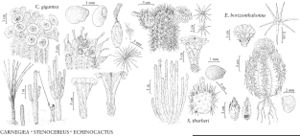Carnegiea gigantea
J. New York Bot. Gard. 9: 188. 1908.
Stems 25+ cm diam., widest where proximal branches arise; pith 10+ cm diam. Flowers usually terminal, 6.5–8.5 cm diam.; scales on flower tubes broadly triangular to rounded, green with red apices; ovary with locule to 25 mm; filaments white, short; anthers tan. Seeds: testa thin. 2n = 22.
Phenology: Flowering early May-late Jun.
Habitat: Sonoran desert scrub
Elevation: 180-1400 m
Distribution

Ariz., Calif., Mexico (Sonora).
Discussion
In its habitat Carnegiea gigantea, the saguaro (also spelled sahuaro), is the most conspicuous and most-studied of all North American cacti. It is the tallest cactus of the flora—indeed, these are the tallest trees of the deserts in the United States.
Its flowers, which open two hours after sunset (R. S. Felger and A D. Zimmerman 2000; J. N. Holland, pers. comm.), are visited at night and during daylight by a variety of potential pollinators, including birds, Leptonycteris bats, and native and introduced insects, which together contribute to high fruit set (T. H. Fleming 1996, 2001). Saguaro fruits and seeds are important food for wildlife. Woodpeckers and small owls nest in the stems. Scar tissue that forms around nest cavities excavated in saguaro stems is later encountered among the remains of a dead saguaro as a hard, brown shell known as a “saguaro boot” because of its shape.
Careless or distant observations of the dehisced bright red fruits are responsible for yearly, erroneous reports of “red-flowered saguaros.” The pulp of the tasty fruits is edible, and for centuries the fruits, available during midsummer, have been harvested by Native Americans as a dependable, annual, indigenous food from which to make wine and jam and obtain seeds (J. G. Bruhn 1971; F. S. Crosswhite 1980; R. S. Felger and M. B. Moser 1985; E. F. Anderson 2001).
The discrete rods of wood (A. C. Gibson 1978), also called “saguaro-ribs,” may persist for years after the death and decomposition of the softer parts of a saguaro. The rods have been used for building materials and to harvest the saguaro fruits (S. Cheatham et al. 1995).
Carnegiea is generally treated as a monotypic genus that shares distant phylogenetic relationships with Mexican species of Neobuxbaumia and Pachycereus, with which it shares alkaloid chemistry (A. C. Gibson and K. E. Horak 1978; A. C. Gibson et al. 1986). Studies using chloroplast DNA sequences currently support that treatment (R. S. Wallace and A. C. Gibson 2002), although sampling of all species in that lineage of columnar cacti must be performed to determine whether any other species should be included in the genus Carnegiea.
Carnegiea gigantea does not occur at sites where soils are saline or subjected to flooding or long periods of freezing.
The saguaro is the state flower of Arizona.
Selected References
None.
